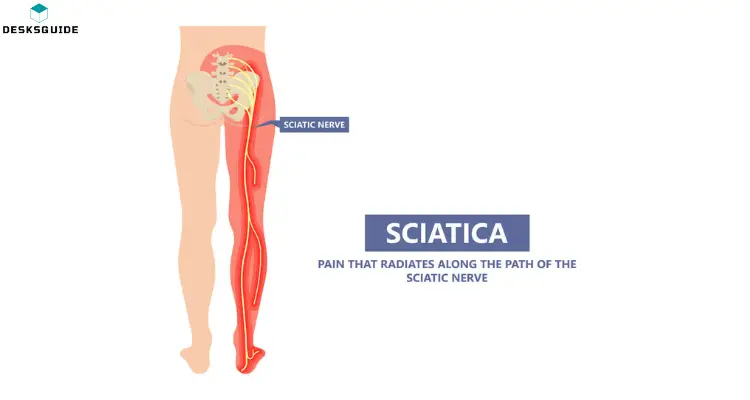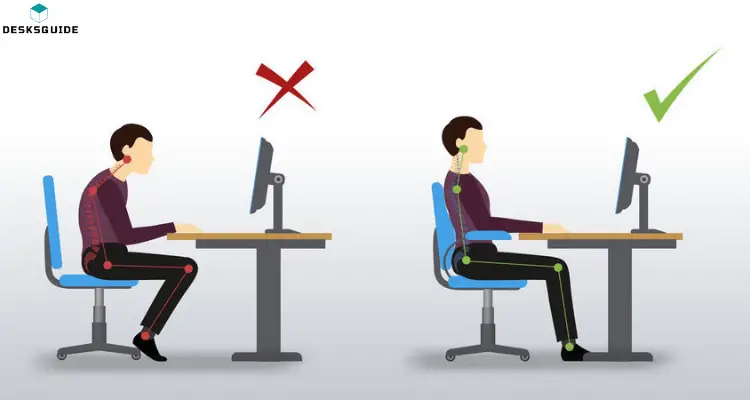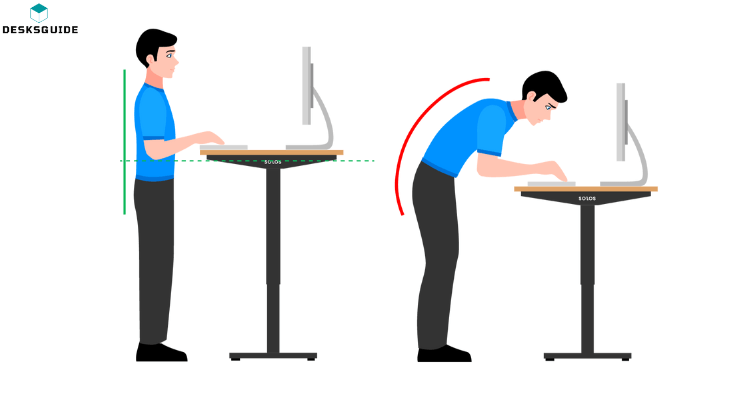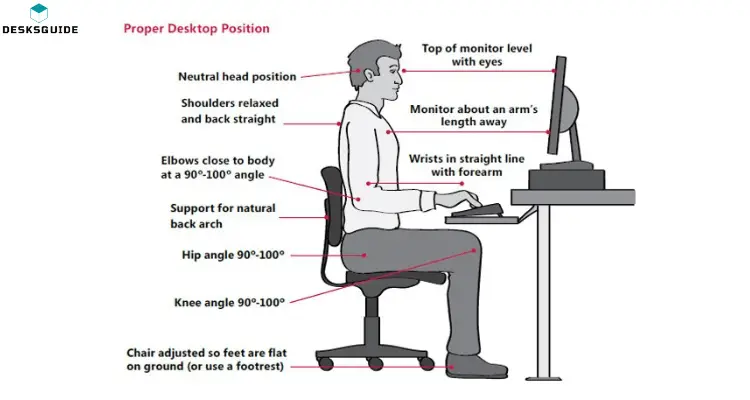Are you fed up with your sciatica pain? and you want to continue working normally, then somebody must have told you to switch to a standing desk. But does standing desk help sciatica? If you want to know this, then you are at the right place.
Table of Contents

People transition from a regular desk to a standing desk expecting to find relief from sciatica pain – and in some cases, that is true. For those who suffer from lower back pain or sciatica, standing desks can offer a range of benefits, including improved posture and increased circulation.
Let’s take a deep look at sciatica, how it is caused, and whether standing desks can provide relief.
What is Sciatica?

Sciatica is a term used to describe nerve pain that radiates from the lower back down the back of the leg. A sciatic nerve runs from your lower back to your toes and is the longest and widest in your body.
Various factors, such as muscle imbalances, poor posture, pinched nerves, and herniated discs, can cause sciatica symptoms to worsen.
Main Causes of Sciatica Pain
1. Muscle imbalances
One of the main causes of sciatica is muscle imbalances. When one set of muscles is significantly stronger than another, it can cause an imbalance in the body that puts extra stress on the sciatic nerve.

Giving your body regular stretching and strengthening exercises can help prevent muscle imbalances from developing and, in turn, reduce your risk of sciatica.
2. Poor Posture
When you are sitting at a desk, chances are that your posture is not ideal. Poor posture can cause the muscles in your lower back to become tight and strained, leading to sciatic pain.

The good news is that standing desks can help with this problem. When using a standing desk, you encourage good posture and allow your muscles to relax, which can help relieve sciatica pain.
3. Inactivity
When you sit for long periods of time, your lower back muscles become weak and tight, leading to sciatica pain.

Standing desks can help to counteract this by allowing you to move around and stretch your muscles, which can help reduce the adverse effects of prolonged sitting.
How to Cure Sciatica Pain?
1. Alternating Heat and Ice Therapy – Fastest Way To Relieve Sciatica Pain
Alternating between heat and ice therapy reduces inflammation and pain from sciatica by reducing muscle spasms and improving circulation. Ideally, ice should be applied for 20 minutes, which narrows vasculature, and heat should be used for 15 minutes, which dilates them. As a result, inflammation is removed, and the blood flows back into the affected area, nourishing tissues and aiding in healing.

2. Physical Therapy
One of the most effective ways to treat sciatica is through physical therapy. Exercises and stretches performed by a physical therapist can reduce sciatica pain and strengthen the muscles causing it. If you cannot find a physical therapist, you can do exercises online. Read on to discover what exercises are available!

3. Medications
If your pain is severe, you may need to take medications to manage your sciatica pain. Seek advice from your doctor to determine which medications are best for you.
Do You Know Prolonged Sitting Tends to Aggravate Sciatica?
Prolonged sitting can worsen sciatica symptoms for many people. This is because when you sit, your lower back has to work harder to support your body which can lead to muscle fatigue. Additionally, sitting for an extended period at your desk, your muscles become tense and can put pressure on the sciatic nerve, causing pain.

Important Note: Sometimes office workers are so busy in their work routine that they overlook the importance of taking frequent breaks from sitting. As a result, they sometimes experience chronic pain in their lower back, which they mix with the simple pain of fatigue. Such pains are the symptoms of sciatica and should not be taken lightly, as they can lead to even more severe conditions if ignored.
So let’s take a look at what exactly sciatica pain feels like so that it can be self-diagnosed.
What Does Sciatica Pain Feel Like?
Sciatica pain normally runs from a person’s lower back down to their thigh, and then below the knee. It can feel like either a dull ache or an intense, burning sensation. The level of pain people experience with sciatica varies depending on what is causing it. Other symptoms associated with sciatica include muscle weakness, tingling, pins-and-needles sensations, or numbness in the affected areas. Sometimes there is also a sharp pain in one part of the leg or hip accompanied by numbness elsewhere in the body.
Now that you know what it feels like, you may question whether it is better to stand or sit with sciatica. Well, the answer to this question is not clear-cut. It all depends on your individual situation and what works best for you.
Is it Better to Stand or Sit with Sciatica?
This is a difficult question to answer definitively as it will depend on the individual and what works best for them. In my experience, though, as well as according to a study in Prevention, standing is generally better for sciatica than sitting. The article states it’s key “to alternate positions for overall spine health.”
In other words, alternating between sitting and standing while working is the best way to reduce discomfort caused by sciatica. Standing desks have become popular recently due to their adjustable height and the ability to switch between sitting and standing positions. This way, you can adjust your desk to a comfortable height and switch between positions to reduce the pressure on your sciatica nerve.

Helpful Tip: It is highly recommended that you also choose a comfortable office chair that provides adequate back support for your lumbar region. It would be best to take regular breaks from sitting, stretch your body often and practice good posture throughout the day.
Does Standing Desk help Sciatica? (06 Tips for Relieving Sciatica Pain with a Standing Desk)
Now that you know the benefits of standing desks and understand the importance of alternating between sitting and standing positions, here are six important tips to help you get started.
1. Avoid Slouching and Hunching
Pay attention to your standing posture, and ensure you avoid slouching or hunching over. Having an adjustable desk is not enough to eliminate sciatic nerve pain, you must maintain a good standing posture to ensure your spine is aligned correctly.

2. Adjust your Monitor to an Eye Level
Adjust your monitor to an eye level, and ensure you keep the screen’s top at the same height as your eyes. Sometimes, fussy monitor positioning can cause neck and back strain, further aggravating sciatica pain.

3. Sitting to Standing Transition
Too much standing can create discomfort, just like a prolonged period of sitting. To reap the benefits of a standing desk, make sure you gradually transition between sitting and standing positions throughout the day. I suggest 15 to 20 minutes standing in front of your adjustable desk every hour.
4. Ensure your back is adequately supported while you sit
When sitting, ensure a desk chair correctly supports your back with adjustable lumbar support. It will help to keep your spine in a neutral position and prevent it from being overly pressured. Adjust the lumbar support as needed to get the best possible fit for your back. A bad chair can also aggravate sciatica nerve pain. But I you want to easily get rid of back pain then I would recommend shifting to a standing desk. You can check out our detailed analysis on whether Standing Desk is good for Your Back.
5. Sciatica-Friendly Exercises
To reduce tension and pain, incorporate stretching and sciatica-friendly exercises into your daily routine. This will help loosen up tight muscles and reduce the pressure on your sciatic nerve.
Some sciatica-friendly exercises include:
- Lower trunk rotations
- Knee to chest
- Pelvic tilt
- Leg extensions and more!
6. Always use Anti-Fatigue Mats
If you are using a sit-stand desk, it is crucial to place an anti-fatigue mat beneath your feet to reduce the amount of pressure on them. Additionally, anti-fatigue carpets can actually help reduce back pain and fatigue overall. Research has shown that after standing for more than one hour, people begin to experience back pain. The sloped and softer surface of an anti-fatigue mat provides extra cushioning and support which helps alleviate lower back pain and sciatica symptoms specifically. You can check out the detailed benefits of using antifatigue mats here in our guide on Should you Wear Shoes at a Standing Desk?

Video Recommendations: Does Standing Desk help Sciatica?
Read also:
Gaming Desk vs Regular Desk (What are the 09 Significant Differences)
Final Verdict: Can a standing desk really help sciatica pain?
The answer is yes! By alternating between sitting and standing positions, good posture, sciatica-friendly exercises, and the use of an anti-fatigue mat, you can successfully reduce the pressure on your sciatic nerve and alleviate sciatica pain.
A standing desk is a great way to reduce sciatic pain and improve overall spinal health and productivity. So, if you’re looking for a way to have a healthy work environment, invest in a standing desk today!
Frequently Asked Questions (FAQs):
Can sciatica stop you from working?
Sciatica can cause shooting and burning pain down your leg, making it hard to focus on anything else. In some instances, the sciatic nerve pain is so excruciating that it might even prevent you from going to work. See a doctor immediately if you have any Sciatica symptoms, such as numbness or tingling in your legs. Additionally, try using a standing desk instead of sitting all day to prevent future pain.
Can sciatica occur in both legs?
Generally, sciatic nerve pain only affects one side of the body. However, there are some cases when people feel this type of pain in both legs. This is caused by irritation or pinching around the sciatic nerve. Both legs may feel sciatica pain if the sciatic nerve is pinched or irritated from both sides.
Can sciatica be cured?
The best way to manage sciatic nerve pain is through rest and physical therapy. In most cases, the pain and inflammation will go away if you take proper preventative steps after 5-6 weeks. However, there are some instances when medical intervention may be necessary. As such, it is always best to consult with a doctor before treating sciatica on your own.
Can sciatica be cured permanently?
In many cases, sciatic nerve pain can be treated successfully with the help of rest, physical therapy, and other conservative measures. However, if there is an underlying condition causing sciatica, then it may need more aggressive treatment from an orthopedic spine surgeon to cure sciatica permanently.
How do I deal with sciatica at work?
To alleviate sciatica pain while at work, taking regular breaks, maintaining good posture, using a standing desk, and investing in an anti-fatigue mat can help. Additionally, engaging in exercises that don’t jar or put extra pressure on the sciatic nerve can also be beneficial.
For sciatica relief, how long should I use a standing desk?
The amount of time you should use a standing desk depends on how long your body can comfortably handle it. A good rule of thumb is to start off with no more than 20 minutes of standing every hour and gradually increase the duration until you reach a point where you can comfortably stand for the entire hour.
I hope you have liked the article, for more latest articles, visit Desksguide.com